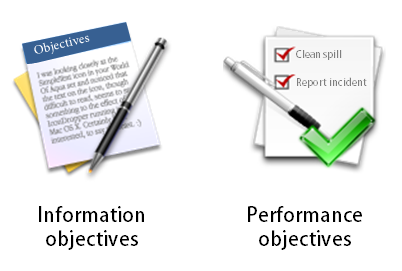Good stuff as always, Tom! Thanks for sharing it. I recently posted a fun little video on a related topic: How to make your SMART objectives even SMARTER. And of course, I built it in Storyline! 😉 http://www.sellonsolutions.com/wp-content/uploads/Objectives/story.html
How to Build Course Objectives That Matter
May 6th, 2014
The key to success is having clear goals and then mapping out a way to meet those goals. Without the map, you’ll never know if you got where you intended to go. In a previous post we looked at how to build learning objectives. Today we’ll take it a step farther and look at a simple process that will help structure the objectives around measurable actions.
What’s the Purpose of the Course?
There are many courses that exist for reasons other than performance improvement. For example, a lot of annual compliance or things like sexual harassment training are usually more about the awareness of policies and less about actionable activities.

On the other hand, there are many courses that do expect that upon completion the learner is able to do something specific. Perhaps they’ve learned a new procedure or how to apply a given policy in the work environment.
Understanding the type of course you build is important because it’ll help you craft the appropriate types of objectives, measure their success, and help you manage your resources.
Ask These Questions to Create Your Course Objectives
Once you understand why you’re building the course you can focus on who is going to take it, why, and what expectations exist after the course. One way to begin is by answering the questions below.
- Who is the learner
- Why is this important to him?
- In what situation would he use this information?
- What is the course objective?
- How does he prove that he’s met the objective?
I create a simple table to look over the answers. Here’s an example based on my experience working for some large organizations.

As part of our ethics training, there was a course on how to deal with bribes. This course was important because we had a number of international sites and many of our sales and procurement staff had to deal with bribery as part of the business culture. Even though we only had a handful of international staff, everyone who took the ethics training had to take the bribery course, regardless of getting bribed.
For the international staff the bribery course was performance-based. We had specific behavioral expectations. For all of our other staff, the objective wasn’t centered on their performance. Instead the objective was to build awareness of the company’s policies on bribery which fit into the larger context of being an ethical organization.
Here’s an example of how this I could have completed the table for this course and the tow different audiences.
Click on the image to see a larger version.
You’ll notice that I broke out the two types of learners and their course objectives. For those who encounter bribes, we focus on the performance aspect. As we build the course, we want to create the types of situations they encounter and have then make the decisions that are in line with the organization’s policies.
For the IT analyst who is never bribed, we create a scaled down course. There’s no need for them to go through time-wasting situations not relevant to their job expectations. In their case, the objective is general awareness of the policy. Presenting the content in an engaging manner and having them certify their understanding is all we need.
A few key thoughts:
- Build the course appropriate to the performance expectations of the learner. If none exist, then don’t force them through the same type of course for those who do have performance expectations. Taking a course costs time which is equal to money. And pulling someone from their work to go through irrelevant scenarios is a time-waster.
- Don’t overstate the importance of the course. Subject matter experts have the tendency to do this. In this example, the temptation is to suggest that everyone needs to be able to make the appropriate decisions so they should all go through the same training. While it’s technically true if presented with a situation everyone should make the right decisions, but forcing people to take certain types of training because of some remote chance that they’ll be bribed is a waste of time.
- Focus on how the learners will prove their understanding. Are they able to make the right decisions in certain situations? How do you know? If the person needs to make certain types of decisions in certain situations then make that the burden of proof. Create situations like they’ll encounter in the real world and have them demonstrate their understanding through the decisions they make. If they don’t encounter those situations, then the level of understanding centers on general awareness. Instead of a decision-making situation, you can focus on the principles that drive the policies. Perhaps a simple case study would do the trick.
I know that some people say the non-performance courses shouldn’t even be built. They should be job aids. Perhaps. But they do get built and often you’re not in a position to force that change. By understanding what the organization expects from the learner you’ll be able to craft good course objectives and determine the appropriate proof to ensure they’ve been met. If they have performance expectations focus on what you want them to do. If it’s about policy awareness, certify their understanding with a simple quiz.
How do you determine the course objectives in your training programs?
Events
- Everyday. Check out the weekly training webinars to learn more about Rise, Storyline, and instructional design.
Free E-Learning Resources
 |
 |
 |
|
Want to learn more? Check out these articles and free resources in the community. |
Here’s a great job board for e-learning, instructional design, and training jobs |
Participate in the weekly e-learning challenges to sharpen your skills |
 |
 |
 |
|
Get your free PowerPoint templates and free graphics & stock images. |
Lots of cool e-learning examples to check out and find inspiration. |
Getting Started? This e-learning 101 series and the free e-books will help. |
11 responses to “How to Build Course Objectives That Matter”
Hi Tom,
Once again you have posted interesting topic on “Course Objectives”; I totally agree with your points (questions) in understanding clients and learner requirement for developing course objectives. Our Instructional designers follow similar strategy in designing Course objectives for elearning modules. Here are few Course Objectives samples: http://www.elearningserv.com/showcase/articulate_storyline/360degree_feedback/story.html
http://www.elearningserv.com/showcase/articulate_storyline/time_management/story.html
Thanks and keep posting.
Rajesh
Lggi qui la traduzione in italiano autorizzata:
Great ideas again Tom! I have been following your posts for quite some time and I really like how you share knowledge that relates to instructional design as a whole and not always focused on eLearning (even though I enjoy it and find it VERY interesting). You mention in your post about building the course appropriate to the performance expectations of the learner. I agree that you don’t want learners to watch or attend a class where they don’t find it value adding. I feel this also applies to instructor led and one-on-one custom built solutions. I feel that teaching learners who have no performance expectations are the hardest to teach. Sometimes these types of learners were told by their manager that they have to attend as part of their role or even a Performance Improvement Plan. These learners are not open to learn, have no expectations, and do not feel they need to attend. So I may not agree with you that it would be a waste of their time. Managers know more than employees think and the classes they require won’t be a waste because it will actually will help the employees.
Part of a designer’s role is to answer those questions you bulleted in this post. Create meaning for learners in the courses will in essence “win them over” and not make it be a waste of their time. I use the same types of questions when creating objectives for my courses. Although creating objectives are sometimes really challenging, your tips in this post are really value adding and appreciated. Thanks again Tom!
Tom,
I agree with your approach of building the two separate bribery courses to match the need of the different learners, but am wondering how realistic of an option this is with clients who are concerned about timelines and cost. How do you approach this option with your clients? I am new to instructional design and work in healthcare, where resources for e-learning are limited.
Thank you,
Jennifer
Hi Tom,
I’m pretty new to Instructional Design – only been building courses for about a year now. I’m also new to your blog – I just started following last week. I agree that it’s so import to know what the purpose is of the course you create because not knowing its background or purpose, puts the Instructional Designer in a tough position because you don’t know what the goals are for course and/or the learner. Before course design begins, those objectives should be in place otherwise the structure of the course will be compromised as well as the learner’s experience.
You make a good point about courses which focus on learners proving their understanding. My company offers a course where the learners are given real world scenarios and must answer questions based on the reading in the course. Whether the learner answers the question correctly or not, pop-up windows are in place to provide the user with real life examples. Correct answers are reinforced and incorrect answers route the learner back to the reading. Providing these types of examples makes the learning more meaningful thus increasing their level of understanding and retention and I think it helps to improve succession rates when taking the quiz at the end of the course.
A comment about non-performance courses – I think they are necessary and should not be job aids. We have a couple of courses on our LMS which are for reference only and they have received a positive reception from our users. The users like going to these courses when they require certain information on the subjects we have posted.
Lastly, I think the table you have in your blog is a good resource and I will adopt its use for future projects.
I’m looking forward to following your blog.
Great Article
Hi Tom,
I am currently in a Learning Theories course for my Instructional Design Master’s degree and am learning about the process in relation to the functions of our brain. Part of assignments are to find blogs that are of value to learning process and being a Learning and Development Consultant I have found value in your particular blog because the information you present is applicable to my everyday responsibilities at work. The reason I feel that the coursework I am currently studying and your post coincide is because a part of making learning effective is showing the value of the content to the learners, for me that starts with your learning objectives or goals. Writing course objectives for my current work group can be very difficult because most of the time they haven’t really identified what they want to achieve with training, they just see a performance issue and fall back on needing more training. I have to complete a lot of needs analysis because identifying that there is truly a training need has been a crucial part of the process but then identifying training goals is the next challenging step. The trend I see in the organizational culture I work for is that they put their employees through training but then there is no evaluation of effectiveness that takes place after, so a lot of time the success of training is solely gauged on the look and feel of training, or their initial experience. There is not time put into how to evaluate if the training had any impact on their performance. I liked how you broke down the process by providing important questions to ask when creating course objectives and a table that can be used that breaks down the process in a simple way. Another process that I have found helpful in creating objectives is related to “action mapping” which not only helps me identify if the issue is truly a training need but also provides a way to create a training that identifies a business goal and ways to achieve that goal in regards to job performance. A great resource for me on this process is located on Cathy Moore’s blog,http://blog.cathy-moore.com/2013/11/how-to-create-a-training-goal-in-2-quick-steps/. Thank you for the great information!
Tom,
I agree that building the two different courses on bribery is best for the learner, but how realistic is this to execute? Are clients willing to do what is best for the learner even though it may require additional time and resources (money)?
Thank you for sharing your knowledge!
Jennifer
Great insight for what it takes to build course objectives Tom! I am a trainer who started in a classroom and now I host webinars. The organization I work for is extremely focused on efficiency. The questions you stated for building course objectives will help me be more efficient. Your key thoughts on understanding the performance expectations and not forcing people to take training if it is a waste of time will help the organization be more efficient. Even though the course topic may be the same, the objective may be different depending on the staff. Thanks again!










0
comments